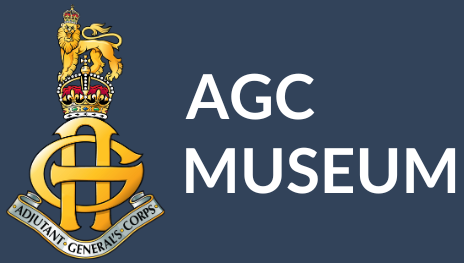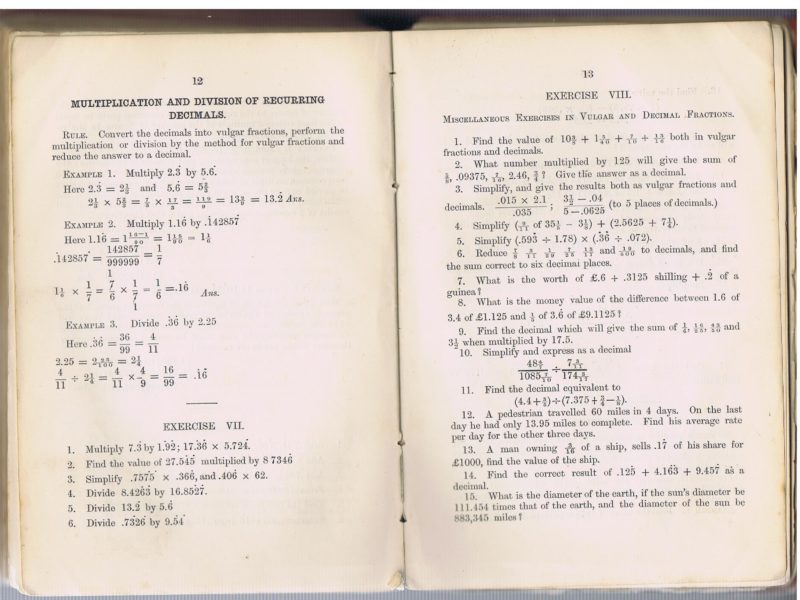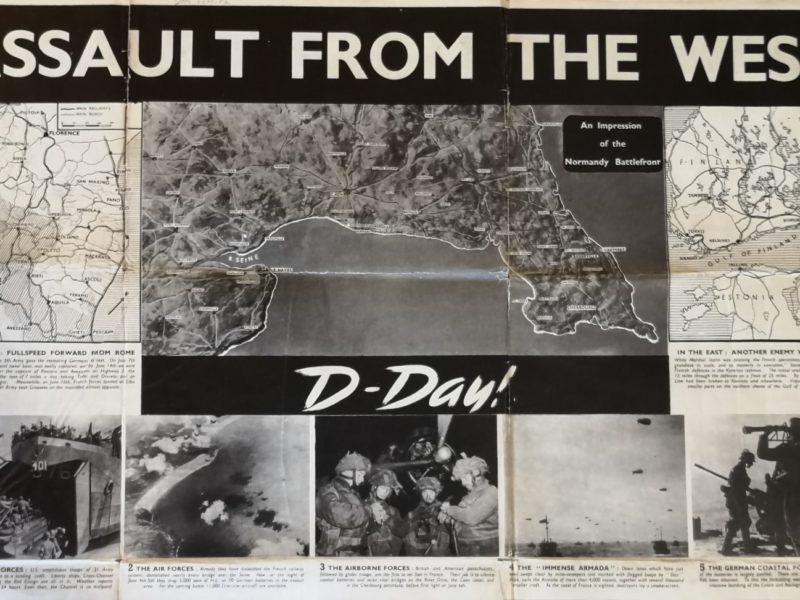Operation Corporate – The Falklands War 20 years on
The AGC Museum Temporary Exhibition
Introduction
The Falkland Islands are a remote archipelago in the South Atlantic, not far from the tip of South America and the Antarctic. The Falklands were uninhabited until its discovery by Europeans in the 16th century, and have at various times belonged to Spain, France, Argentina, and Britain. At times, these countries co-existed peacefully on the islands.
British rule of the Falkland Islands (Islas Malvinas in Spanish) was reasserted in 1833, although the Argentinian government protested and have done so since then. The Falklands have traditionally included territorial claims to areas in the Antarctic.
On 2nd April 1982, Argentinian forces invaded the capital, Stanley, and quickly defeated the small British garrison. They then took control of South Georgia island. By the end of the month, 10,000 Argentinian troops were stationed on the Falklands. They were mostly poorly trained and equipped conscripts.
The British Prime Minister, Margaret Thatcher, declared a war zone for 200 miles around the Falklands, and a naval task force of HMS Hermes and HMS Invincible were assembled, with the use of the cruise ships Queen Elizabeth II and Canberra acting as troop ships. Other ships joined the force en-route.
The British forces quickly retook South Georgia, and on 2nd May the Argentinian cruiser General Belgrano was sunk by a British nuclear submarine. On the Falklands, the British naval force and the Argentinian land forces fought pitched battles. The Argentinian aircraft were mostly old US and French fighter-bombers and lacked the technical capabilities of the more modern aircraft of the time. They had to fly to the extreme edge of their abilities, so could only make one pass at the British force, which stayed out of their range unless closing in to make an attack.
British ships were also vulnerable to attack, and on 4th May HMS Sheffield was sunk. However, the Argentinians lost some 30% of their aircraft.
The British made an amphibious landing near Port San Carlos, on the northern coast of East Falkland to mount an attack on Stanley to avoid casualties of not only the British forces, but of the British civilian population of the islands as well. The Argentinian commander, General Mario Menedez, thought the British would assault Stanley directly and had his troops positioned accordingly.
The British landed with little opposition on 21st May, and quickly pushed south. Whilst the Argentinian air force attacked the British fleet, it did not do enough damage to jeopardize the landings.
The settlements of Darwin and Goose Green were the first to be captured, and after several days of hard fighting the British forces occupied the high ground west of Stanley. Knowing that they were surrounded, and the main port was blockaded, General Menendez surrendered on 14th June 1982.
The antecedents of the Adjutant General’s Corps (AGC) took part in Operation Corporate in fighting and supporting all branches of the military at home and in the Falklands.
The antecedents and the current Corps were and are attached to units on operations abroad and have taken part in all wars and conflicts since their formations.
The Royal Army Pay Corps
The first RAPC personnel sailed onboard the QEII on 12th May, making sure to have sufficient cash onboard as well as facilities to draw on cash if needed. The first request onboard was to pay 300 RAF. Once at Ascension Island, the RAPC took on paying of the Royal Marines, and SO2 Finance Headquarters 5 Infantry Brigade was appointed Force Paymaster. All onboard were paid three weeks pay prior to going into battle. The Force Paymaster was asked to keep all non-essential people onboard and transferred to the Canberra.
The Force Paymaster, along with 7 Paymasters and 48 military accountants established a Field Record Office and a Field Cash Office. The Field Record Office assisted in the clearing of personnel effects from the Goose Green/Darwin battle, identified the dead, sent notice signals to the UK for notifications, and sent daily casualty signals. They also processed POWs from Goose Green/Darwin, although this was later transferred to ships. After the end of the conflict, the FRO moved from San Carlos to Stanley. The Field Cash Office not only paid soldiers, but also members of the Royal Navy and the Royal Marines and supported the pay parades of the RAF. They also paid for local services such as local purchases, billeting, and stationary. The FCO also took on paying of civilian compensation claims.
In the operational area, the RAPC took on extra roles, including movement of ammunition and rations, helicopter handling, stretcher bearing with forward troops, dealt with the mail and NAAFI supplies and located the evacuated wounded. The also helped with the processing of Argentinian POWs onboard ships and acted as supply porters during the assault on Stanley. The RAPC also helped exchange Argentinian pesos for Falklands currency and completed the handover of the new supply of Falklands currency.
The Royal Army Educational Corps
The lead up to deployment for the 3-man RAEC team was to supply educational and entertainment support to the troops. This support included 56 entertainment films, 70 films on video cassettes, 9,000 books, and £2,100.00 worth of adult boxed and board games along with the supporting hardware. The team boarded Queen Elizabeth II, with items spread across two ferries and the QEII itself. They set up in the Atlantic Shop, with a further donation of games and 4,000 books. Each unit was issued books and packs of assorted games and offered a full range of film and video shows on board. By day 3 educational courses were offered, ending in examinations. A daily broadsheet was also produced.
Once in theatre, the RAEC offered welfare and entertainment to the survivors of HMS Coventry, HMS Ardent, and HMS Antelope. The RAEC stayed aboard the QEII, travelling to Ascension Island, and later on the Dumbarton Castle until they returned south. They produced a daily newssheet and put together a military training programme. They finally arrived in the Falklands on 19th June.
Once in Stanley, the RAEC, with the support of the RAF’s Liquid Oxygen Section, helped to re-establish education on the island for the residents’ children by the end of June/beginning of July. This included the setting up of the classrooms as well as teaching classes. At this time an Education Centre was also set up to start education courses for the serving soldiers. Eventually the civilian teachers returned, and the RAEC continued with educational provision and resettlement interviews. Welfare and entertainment were also an important element, with the issue of films and video cassettes, the distribution of newspapers, and contributions to the Penguin News with the editing done by civilians.
Royal Military Police
RMP Detachment Headquarters 5 Infantry Brigade boarded the Queen Elizabeth II on 12th May as part of 3 Commando Brigade. On the way to the Falklands, they took part in training, running an information desk, and maintaining discipline patrols onboard. They were eventually cross-decked to other ships.
The RMP were responsible for the detainment of Captain Alfredo Astiz, who was the only Argentinian POW to be flown back to the UK. He was held for questioning in the Keep at Roussillon Barracks, Chichester, the home of the RMP before being repatriated to Argentina in June.
Once landed at the Beach Support Area at San Carlos settlement, the RMP detachment began digging trenches to protect against Argentinian airstrikes. In the run up to the assault on Stanley the RMP assisted with the buildup of supplies at the BSA, established an Information Post to direct and control personnel movement on the island, and marshalled helicopters into the areas where supplies were to be dropped. An RMP reconnaissance party witnessed Bluff Cove and provided close protection escort to Brigadier Wilson.
As the military pushed south, the RMPs controlled prisoners of war, joined by the Royal Marine Police. By the time of the news of the Argentinian surrender, the RMP handled the processing of some 430 POWs.
However, their work was not complete. In the immediate post-war week, they patrolled the streets of Stanley to restore order, helped the sole civil policeman re-establish the Police Station and processed 11,000 prisoners for repatriation to Argentina. By 24th June the RMP were back to General Police Duties role in the Falklands Islands.
Military Provost Staff Corps
The MPSC were responsible for the escort of Captain Alfredo Astiz from Ascension Island to the RMP Training Centre, Chichester, in May 1982. Five members of the Corps were sent from the Military Corrective Training Centre (MCTC) Colchester to Ascension Island. Once they arrived, they collected the prisoner and boarded MV British Avon, a BP oil tanker, for the return trip.
The engineering department of the oil tanker were responsible for the fit out of Capt Astiz’s cabin from instructions given by the MPSC, all made from scratch and fitted within a day. They boarded on 25th May for a ten-day journey back to the UK.
Astiz told the MPSC that he would attempt to escape if given any opportunity, even if it meant jumping overboard near land. As a result, he was watched at all times whilst onboard. This meant that the MPSC all took alternate 6-hour shifts for the entire journey.
The transfer to the cutter on arrival at Southampton Docks on 4th June did not go smoothly. However, they were met by an RMP detachment to escort them to Chichester once on shore. The MPSC were responsible for the security of Capt Astiz for his stay at the Keep with support from the RMP. Again, he was watched at all times as he claimed he would attempt escape.
An MPSC officer escorted Captain Astiz to Rio de Janeiro on his repatriation, and the contingent was back in Colchester by 11th June 1982.
Army Legal Corps
Members of the ALC did not take part in the initial wave of military down to the Falklands. The first ALC officer deployed shortly after Stanley was retaken by the British. Part of his duties were handling prisoners of war and their repatriation. However, by the end of 1982 there was not enough work to justify an ALC presence on the islands.
The main work by the ALC was at home, working on the distribution of the South Atlantic Fund, a large pot of money from public donations to help servicemen injured during the campaign and the families of those killed. A South Atlantic cell was set up in Aldershot, which gathered and evaluated claims and advised the trustees of the fund. This work would continue for two years after the end of the Falklands War.
The ALC also began the task of producing a new Tri-Service Manual on the Law of Armed Conflict.
Women's Royal Army Corps
Members of the WRAC did not take part directly in Operation Corporate. At this time, women in the Army were generally kept away from front line roles. The first WRAC draft of 20 WRAC arrived in Port Stanley on 1st August 1983, to support the re-established permanent garrison on the Falklands as part of the larger military presence on the islands.
After the Conflict
The legacy of the Falklands War is two-fold: a devastating blow to the military junta governing Argentina and a decided victory for Margaret Thatcher, whose popularity was at a low ebb until the end of the conflict. The government of Argentina was returned to civilian power and elections were held for the first time in a decade, and Thatcher’s Conservative government won a decisive victory in 1983.
For the Falklands, it has meant a long-term policy of military presence, including the building and maintenance of RAF Mount Pleasance. The large number of mines used by the Argentinian forces during the war meant that the Falklands were not declared free from mines until 2020, although there were no accidents reported since 1984.
Were you a member of one of the antecedents and took part in the Falklands War? Please contact the museum office if you would like to record your experiences. The AGC Museum is committed to recording and preserving the stories of those who have served, past and present.
Objects on Display
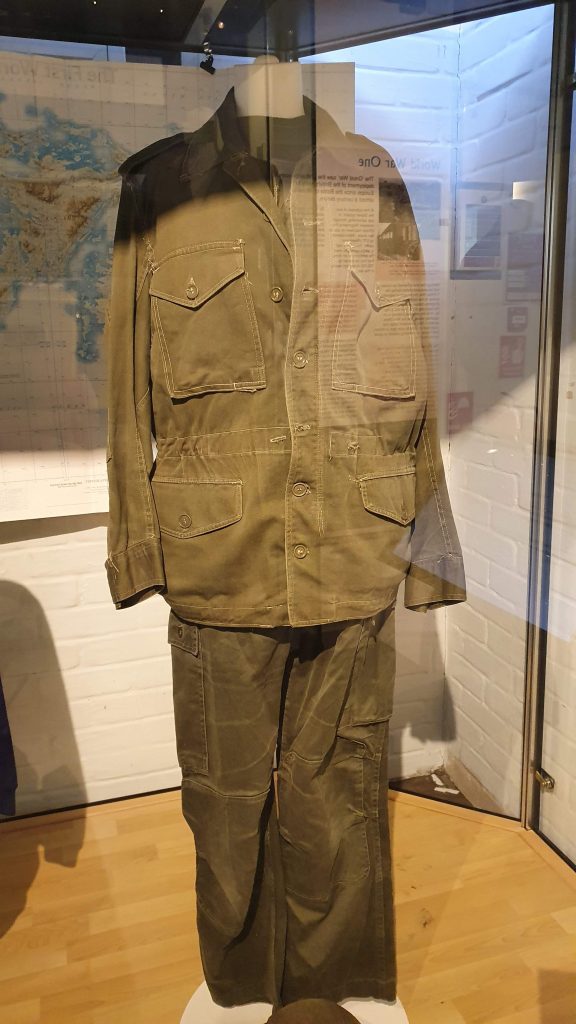
The full uniform display belonged to a captured Argentinian uniform consisting of tunic, sweater, trousers, and helmet. Many of the uniforms and equipment used by the Argentinian forces were old US and French military items. The most common comment regarding the Argentinian POWs was their lack of new equipment and proper uniforms.
The sweatshirt was worn by a member of the RAEC in the mid-1980s, after the conflict. A larger garrison was completed in 1985 to keep a larger military presence in the Falklands as a deterrent.
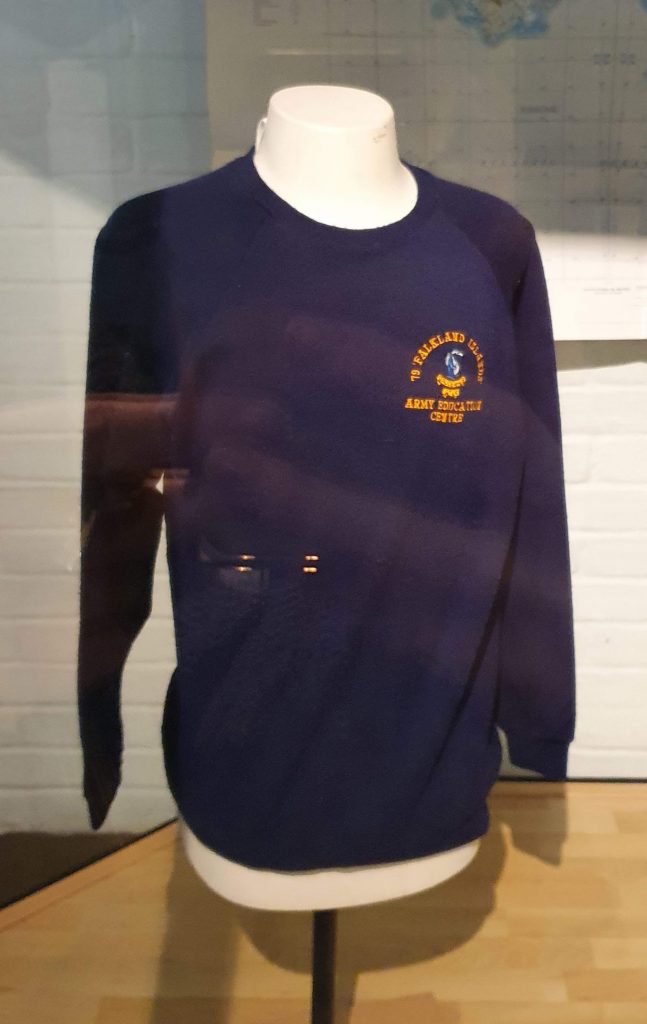
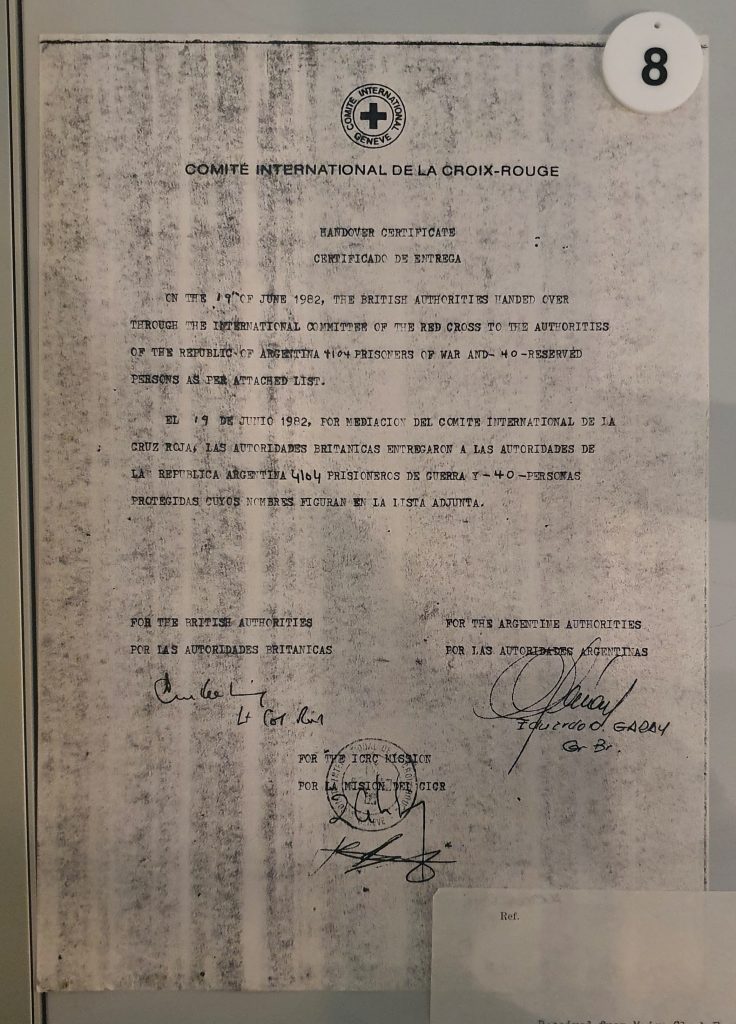
Copy of the Argentinian surrender document
Front page of The Penguin News, the local newspaper of the Falkland Islands, to record the end of the conflict
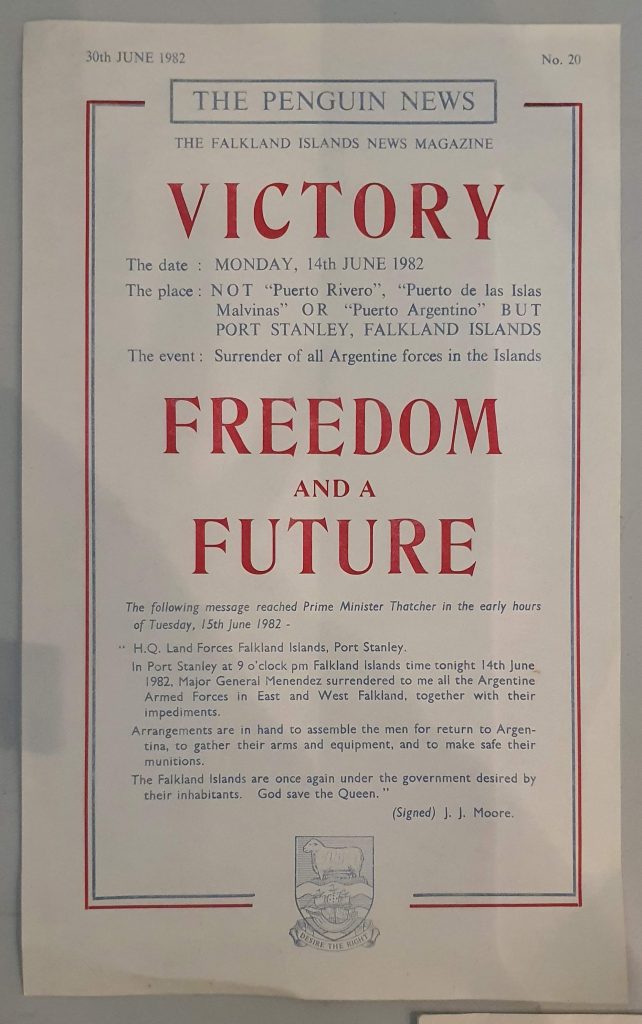
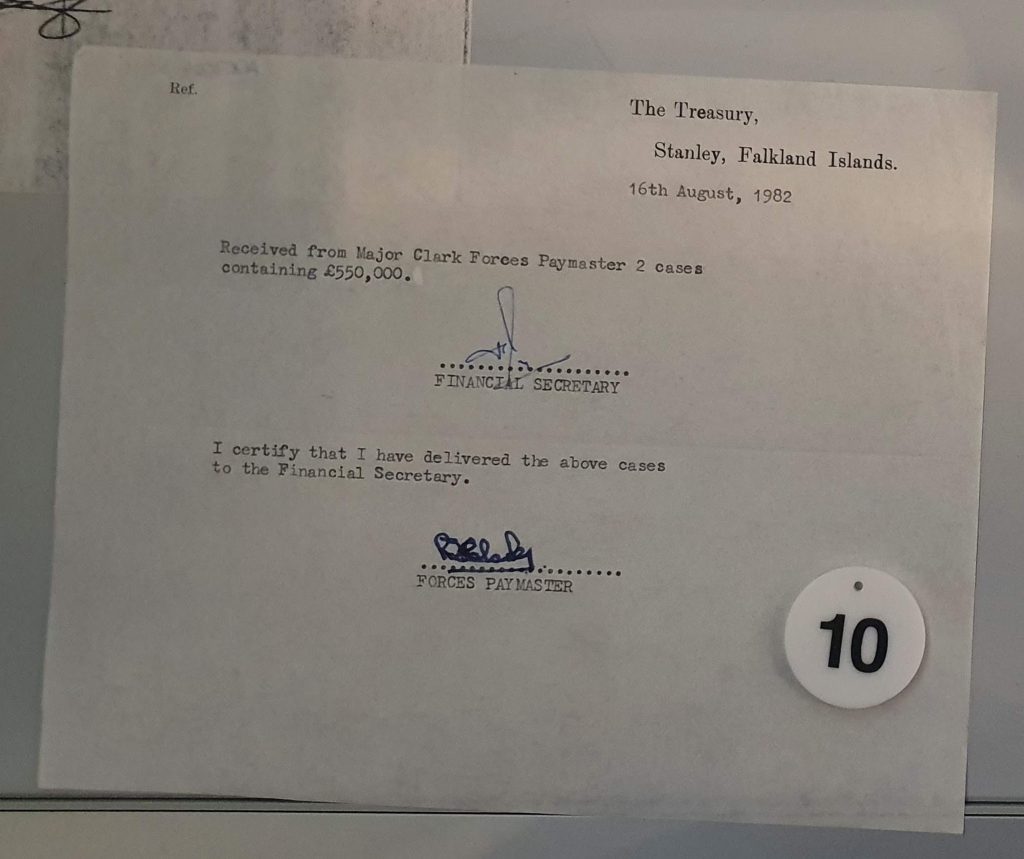
Signed receipt for the new batch of Falkands currency, received 16th August 1982
Order of Service to commemorate those who were killed during the Falklands War, 25th October 1982
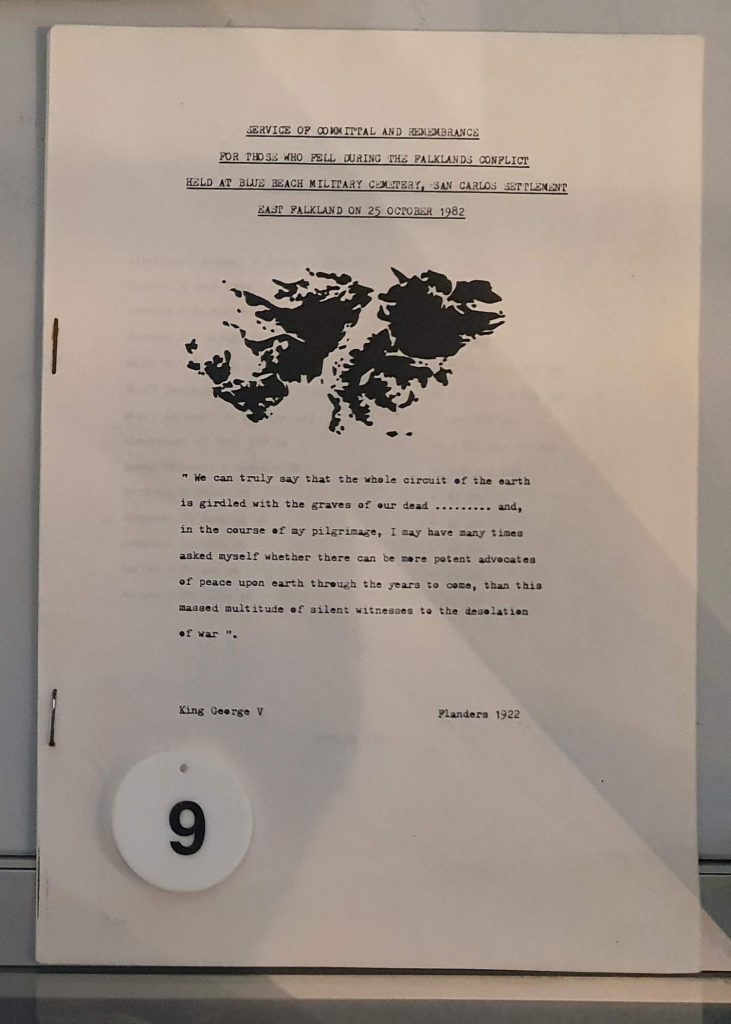
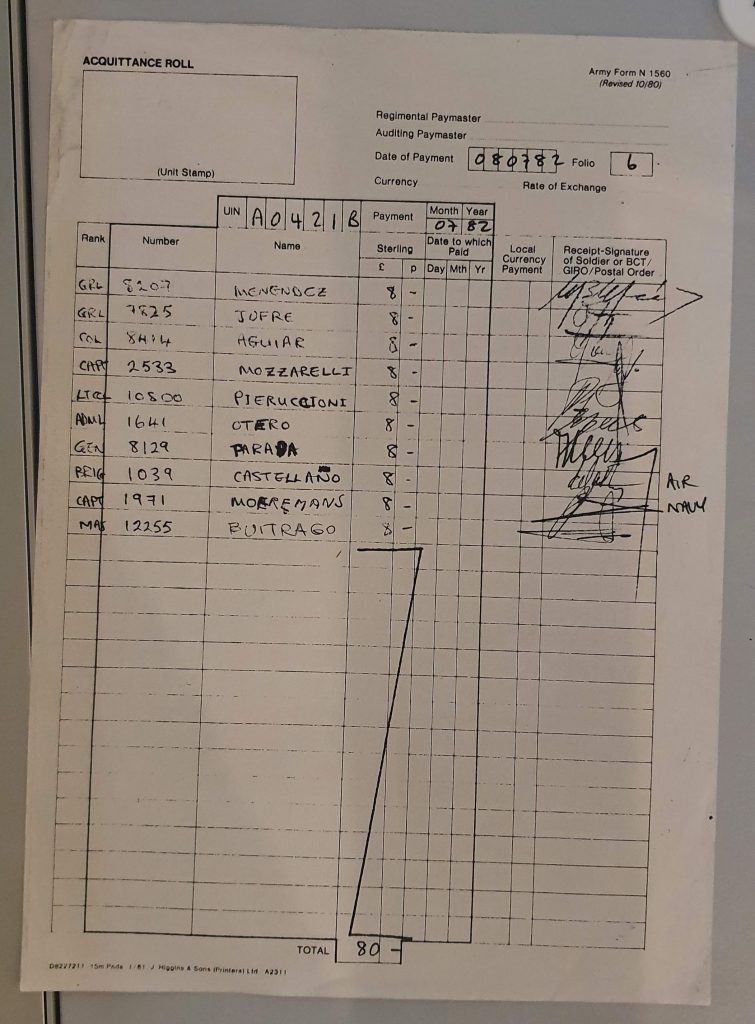
Copy of a list of prisoner of war payments made to senior Argentinian POWs, including General Menendez
Menu from the Queen Elizabeth II on the first day of the deployment
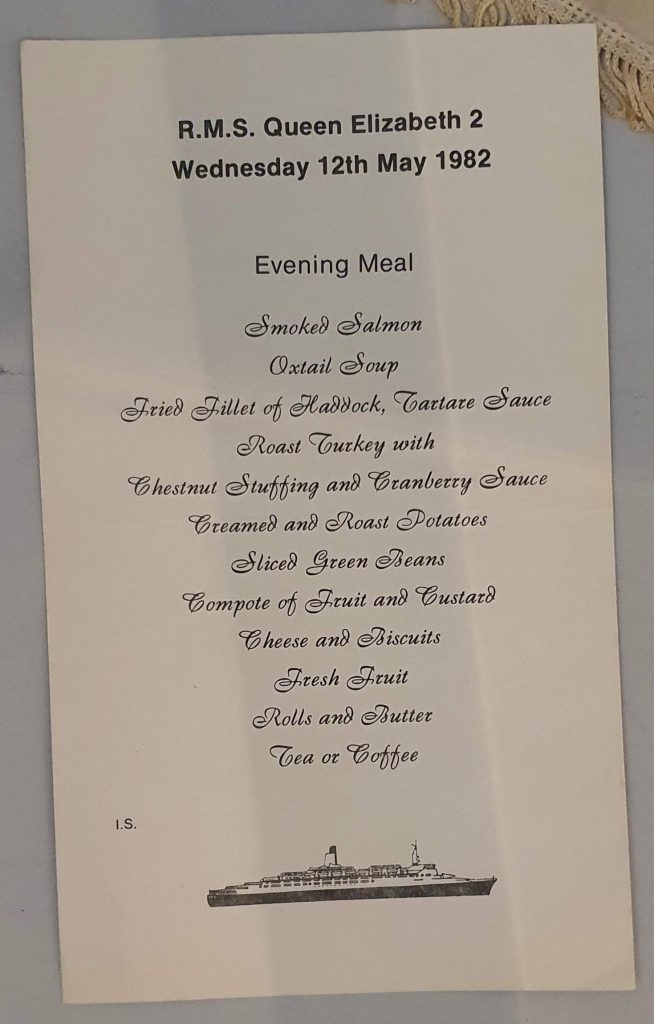
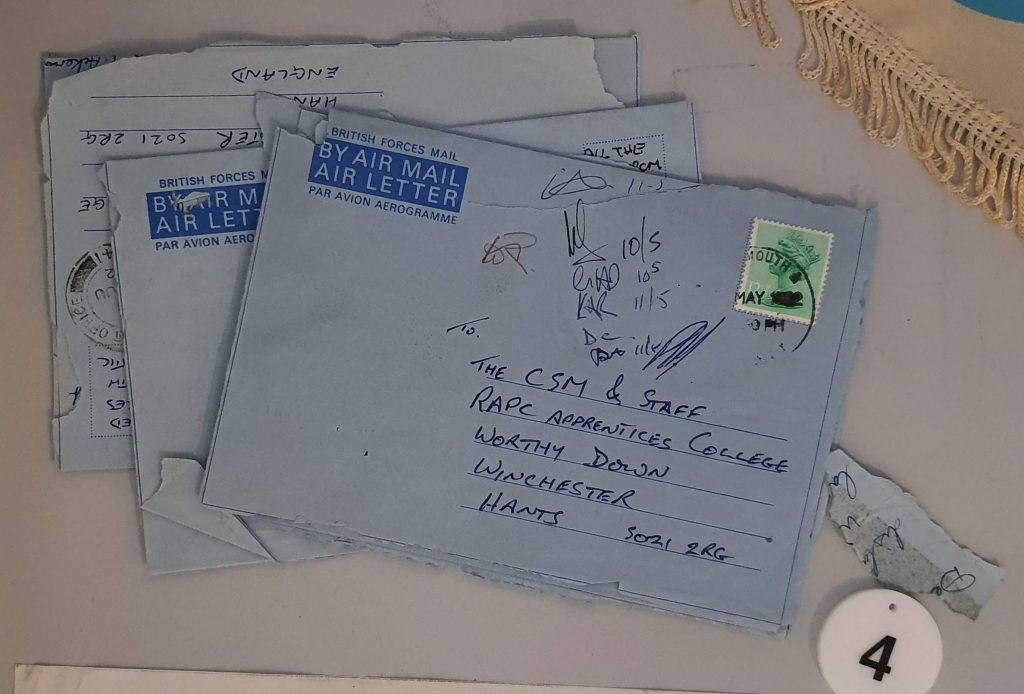
“Blueys” from RAPC NCOs to the RAPC Apprentices College, detailing the work they were undertaking as part of the Falklands Campaign. They served with 2 Paras and the Royal Artillery
Bottle of Forces Pale Ale, one of a special batch presented by the Sunday Mirror to participants in the Falklands Islands
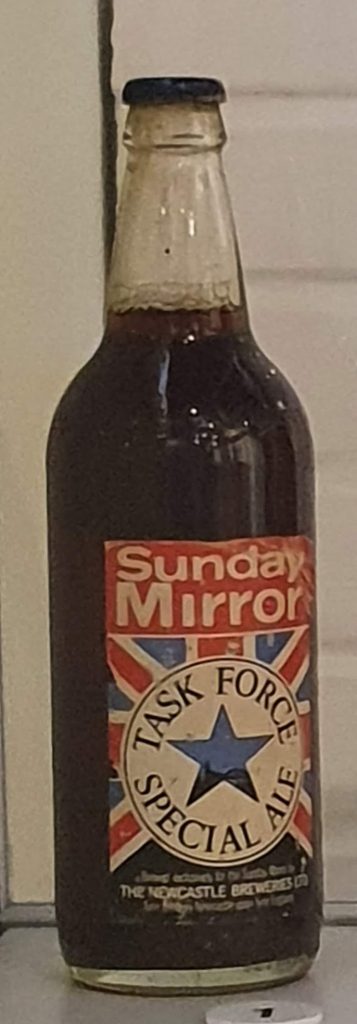
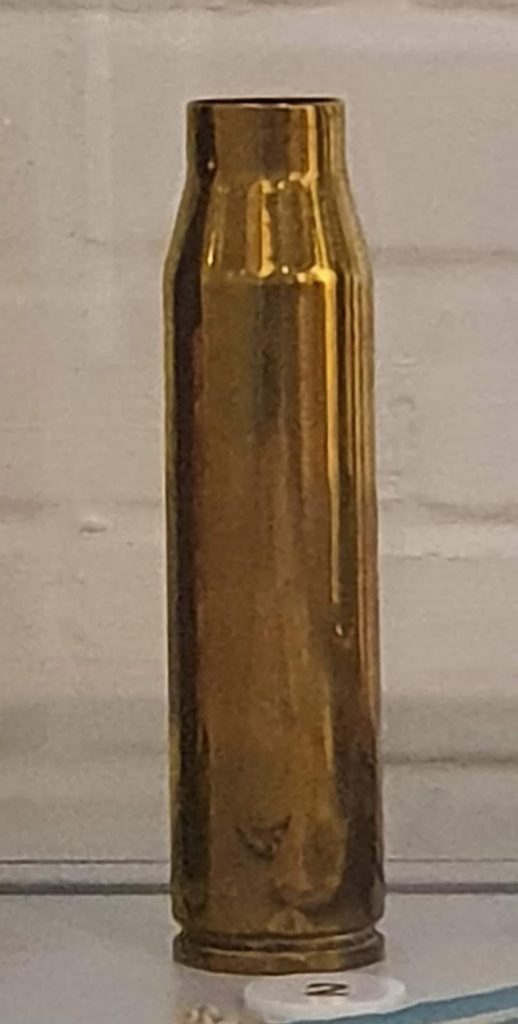
30mm AFV shell case brought back from the Falklands by an RMP officer
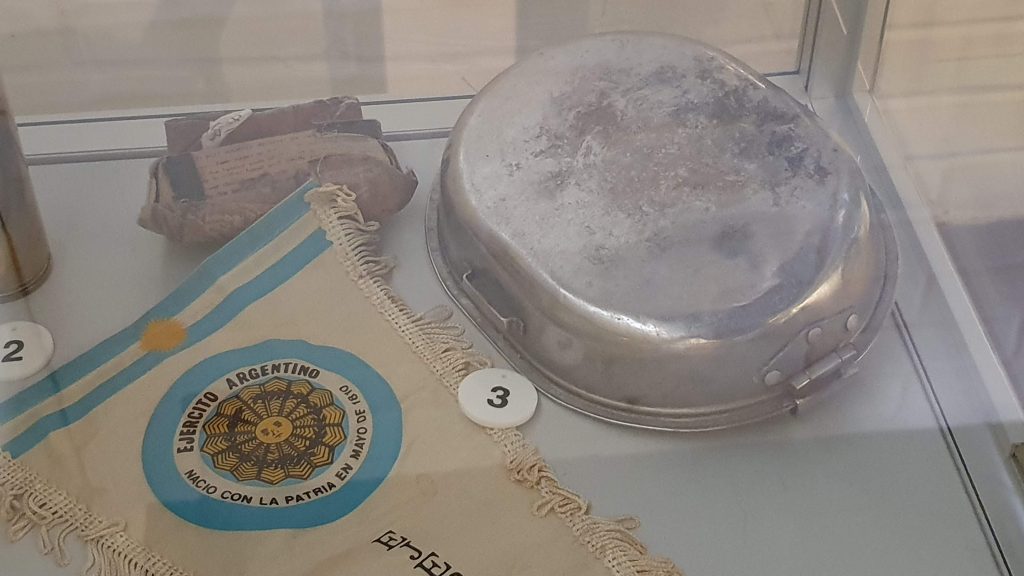
Captured Argentinian equipment, including a mess tin, pennant and bandage
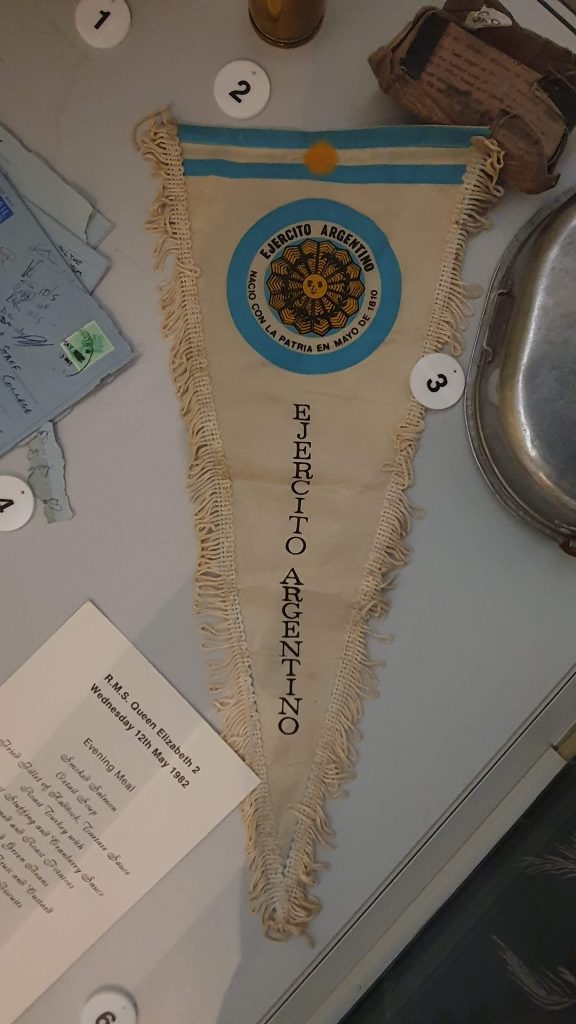

This topographical map was printed in 1982 and includes lists of populated places and important infrastructure such as roads and railroads.
Minefield situation map produced four months after the Falklands War. As no minefield map was produced by the Argentinian forces, the minefields were not completely cleared until November 2020. In the first two years after Operation Corporate there were several accidents involving mines as the British military were having to test fields resulting in loss of life.


